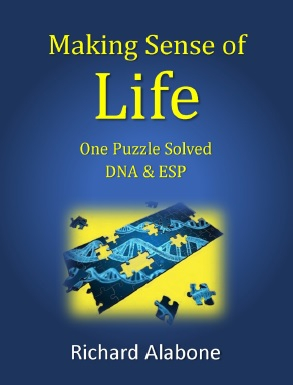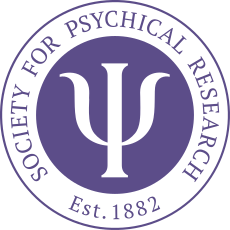
Reviewed by Gregory M. Westlake
The day will come when this will be given as a curious illustration of the blindness of preconceived opinion – Charles Darwin
Richard Alabone has been studying psychic experiences for more than 60 years. He has retired from a career as a research and development engineer on radar, film and television equipment. Alabone has several patents to his name and has also worked, for nine years, as a Civil Service technical manager. In 2011, during 40 broadcasts, Paranormal is Normal, he spoke to many interesting people who experienced the psychic side of life. He has written a couple of books since then. Making Sense of Life: One Puzzle Solved DNA and ESP is his very latest book, and perhaps the most refined and easy to read.
Alabone’s passion to understand the paranormal has led him to study biology and to propose a radical theory. His new book is bold and thought-provoking – it challenges scientific theory, and claims to correct serious flaws to be found in biological theory. This is a charming slim tome, eccentric, ambitious, and highly imaginative. Alabone has made a mission of his life to highlight the importance of telepathy, and ‘brain sharing’ or, as Carl Gustav Jung precisely stated the ‘Collective Unconscious’. If I understand Alabone right: This being the true common fundamental psychic mechanism – the instinctive one mind of the human species communicating via microtubules between the members of our species.
Alabone has purified his sophisticated thought into 80 pages, an appendix, and a useful reference list. The work is logically divided into ten chapters, all straightforward and uncomplicated; hugely informative, and a real pleasure to read, even if you do not accept his findings. His scholarly penmanship is spellbinding, and so, this erudite content is a welcome new contribution. Alabone writes:
For seventy-seven years, we have been told that genes are a book of instructions, but this hypothesis is in doubt, as no mechanism has been discovered (p. 11).
Alabone argues that geneticists have spent billions trying to sort this out, all to no avail and it’s still “not fully understood” (p. 11). He admires the biologist Rupert Sheldrake for questioning regeneration, reproduction, and regulation; and promoting his elegant theory of ‘morphic fields’. However, he suggests that Sheldrake cannot explain how they work, and argues that biologists’ mantra of self-assembly is just not good enough.
The whole history of science shows us that whenever the educated and scientific men of any age have denied the facts of other investigators on a priori grounds of absurdity or impossibility, the deniers have always been wrong – Alfred Russel Wallace.
In science community there has always been a taboo against even mentioning the word telepathy. It is never discussed, being dismissed as wishful thinking, fraudulent, or the result of defective, faulty experimentation. Could all paranormal phenomena (or witchcraft) have a common origin – mind to mind, or telepathy? What could be the carrier of telepathy and morphic fields? Perhaps the answer has to do with quantum science, or quantum biology: quantum particles, waves, fields or rays. Perhaps, DNA works indirectly, rather than directly, by always copying incoming information from each parent. This new perspective presents a duplication mechanism reliant on a hypothesised quantum carrier.
Moving on to chapter three, ‘The Wonders of Biology’; where we encounter vital questions concerning morphogenesis, DNA, microtubules and the ‘New Core Theory’. Alabone poses six major questions for embryologists, concerning the concept of morphogenesis that have yet to be answered in terms of a mechanism. Alabone’s thinking revolves around the notion, and theory of human growth. Life tries all possible ways to evolve into being a better survivor. Synchronicity is also a useful idea when considering the mechanism of ‘brain sharing’, microtubule biology, and biological waveguides, which can be both transmitters and receivers. The new core theory states that it is not the DNA’s direct instructions that dictates human form, but the inheritance copied from the parent’s flow of quantum information, via a data transfer from a certain specific dynamic of ESP.
Penultimately, the next chapter deals with Alabone’s thoughts and experiences with telepathy and ESP. Alabone notes that, for example, Ganzfeld studies have produced evidence of ESP; however, he complains about organized sceptics produce misinformation. Alabone finalises his chapter by declaring that inheritance flows directly from the parents’ families to the growing child in a similar way to our radio networks, heat, and light occurrence.
Finally, to reflect upon, is that Alabone’s entire life work, his new core theory, would generally be considered scientific heresy. He claims that the transfer of genetic information from one body to another by his new hypothesised mechanism, previously unimagined by scientists, enables the replication of the parents’ DNA codes. In other words, life must be seen as a perpetual copying machine. So, we have been wrong since the days of the physicist, Nobel laureate Erwin Schrödinger, having written the book What is Life, stating that essentially DNA is a set of instructions.
Alabone explains that it is clear to him that all life owes its growth to psychic inheritance: “All growth is psychic inheritance: AGIPI” (p. 68). This basic transferring principle could transmit life’s information by an entirely different mechanism. The basic mechanism is AGIPI where DNA enables a psychic connection via primary cilia, microtubules, brain, and stem cells. A certain kind of bioelectricity between cells, with microtubules being the quantum carrier of biological information. This new theory and interpretation of evolution may explain epigenetics.
To conclude, it is evident that Richard Alabone has had a lifelong deep passion for this subject, constantly refining, and perfecting his work. It would seem that he simply cannot write an uninspiring sentence; the enormity of the ground covered in this slim book is utterly impressive. The work need not leave you bemused or mystified, but simply thoughtful and animated. Eccentric, maybe, but undeniably moments of beauty. Recommended to inspirit your mind.
Gregory M. Westlake can be reached at email: [email protected]

